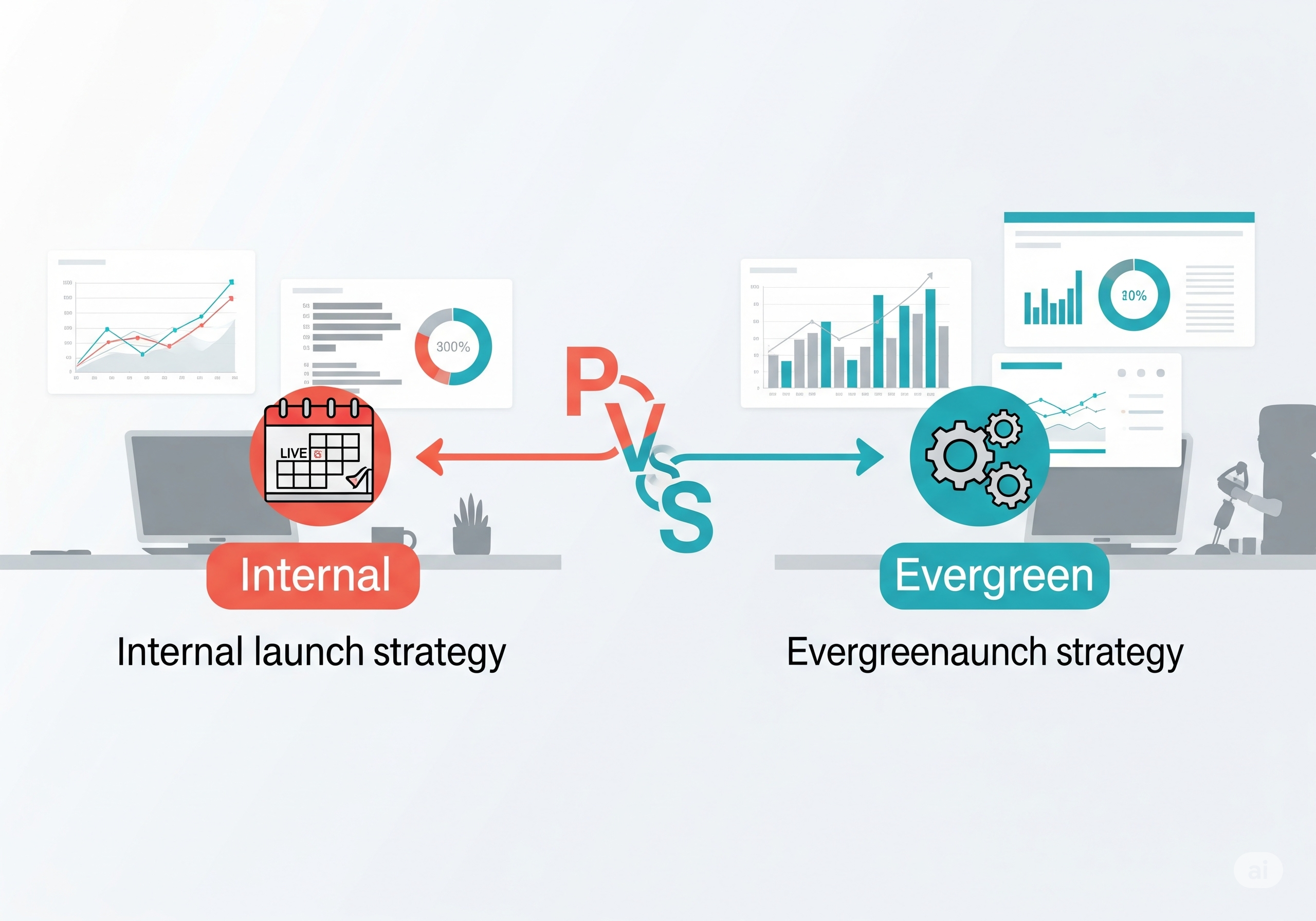Choosing between an internal launch and an evergreen model is one of the most strategic decisions a co-producer will make. Each model shapes how the product is presented, how revenue is generated, and how long the collaboration must stay “active.” While both approaches have unique strengths, choosing the right one depends on your goals, audience, team capacity, and the lifecycle stage of the course.
This article explores the differences between internal and evergreen launches in co-production, their pros and cons, and how to decide which path—or combination—is right for your course and your partnership.
Let’s start by defining each strategy in the context of co-production.
Internal Launch (Live or Limited-Time Launch)
An internal launch is a short, focused campaign where the course is made available for a limited time, usually to a pre-built email list or social audience. The team builds anticipation, warms the audience, and opens cart for 5–10 days. After that, access closes until the next launch cycle.
Evergreen Launch (Always-On Model)
An evergreen launch uses automated systems to sell the course continuously. New subscribers enter a funnel, get value through lead magnets or email sequences, and are presented with an offer that includes some form of urgency (limited-time bonuses, countdowns, etc.). There is no official “launch day.”
Let’s break down the differences between these models through core dimensions that matter to co-producers.
1. Revenue Generation and Cash Flow
Internal Launch:
- Large influx of revenue in a short window.
- Can fund future ads, tools, or project expansion.
- Risk of burnout or disappointment if the launch underperforms.
- Unpredictable cash flow between launches.
Evergreen Launch:
- Generates recurring, predictable income.
- Allows long-term financial planning and reinvestment.
- Slower revenue build-up in the beginning.
- Requires traffic generation (SEO, ads, content marketing) to sustain.
2. Marketing Style and Pressure
Internal Launch:
- High-pressure campaign: urgency, countdowns, live events.
- Requires intense preparation: webinars, scripts, bonuses, segmentation.
- “All in” energy that builds excitement and momentum.
- Risk of overwhelming the expert, especially on camera or live sessions.
Evergreen Launch:
- Low-pressure but consistency-dependent.
- Relies on automation: sequences, tools, logic.
- Removes the stress of live events.
- Needs regular monitoring and updates to stay relevant.
3. Ideal Audience Behavior
Internal Launch:
- Works well for audiences who need urgency to make decisions.
- Appeals to fans who respond to events and hype.
- Converts warm leads effectively (especially email lists).
Evergreen Launch:
- Appeals to learners who discover you over time (via SEO, YouTube, podcasts).
- Great for impulse buyers who don’t want to wait for the next opening.
- Allows for personalization at scale.
4. Team Structure and Capacity
Internal Launch:
- Demands intense collaboration for a few weeks.
- Suits teams that can handle sprints and deadlines.
- Requires live presence: Q&As, DMs, support waves.
Evergreen Launch:
- Works best with structured systems and long-term workflows.
- Allows asynchronous work between co-producer and expert.
- Minimizes disruption in the expert’s routine.
5. Content Strategy and Lead Nurturing
Internal Launch:
- Leans heavily on a pre-launch runway: warm-up videos, emails, lives.
- Launches work best with strong brand storytelling.
- Requires short-term spikes in content output.
Evergreen Launch:
- Leans on long-term visibility through content engines.
- Benefits from strong lead magnets and evergreen SEO.
- Needs nurture emails and retargeting to maintain engagement.
6. Student Experience
Internal Launch:
- Often includes a live component: community, calendar, bonuses.
- Builds a sense of belonging and urgency to act.
- Can foster higher completion rates if guided well.
Evergreen Launch:
- Students can join anytime—at their peak of need.
- Experience is often solitary unless community features are built in.
- Risk of lower engagement if not supported by automated nudges.
7. Conversion Rate
Internal Launch:
- Higher short-term conversion due to urgency and FOMO.
- Taps into emotional momentum.
Evergreen Launch:
- Lower daily conversion but higher volume over time.
- May require multiple touchpoints before purchase.
8. Tech and Automation Requirements
Internal Launch:
- Requires page builders, live webinar platforms, email sequences, tracking tools.
- Short-term automation setup (may be reused later).
Evergreen Launch:
- Needs advanced automation tools: Deadline Funnel, webinar automation, behavior tagging.
- Funnel logic and evergreen testing are critical.
When to Choose an Internal Launch
- It’s your first launch, and you need real-time feedback.
- You want fast validation and revenue.
- You already have an engaged audience ready to buy.
- The expert prefers live connection and momentum.
- You’re testing product-market fit.
When to Choose Evergreen
- You’ve validated the course in a live launch.
- You want to scale or build passive income.
- The expert has limited time or availability.
- You plan to invest in SEO, ads, or long-form content.
- Your audience is highly digital and ready to purchase any time.
Can You Combine Both? Yes—Smart Co-Producers Do.
The hybrid model is powerful. Launch live once to validate, then build evergreen systems from that foundation. Use:
- Internal launch = build cash flow, urgency, social proof.
- Evergreen launch = scale reach, automate revenue, reduce effort.
Some use internal launches for upsells, bundles, or seasonal bonuses—while evergreen remains the default engine.
How to Transition from Internal to Evergreen
- Analyze Your Launch Funnel: Which emails and pages performed best? Reuse them.
- Automate Your Webinar or Presentation: Tools like EverWebinar or Loom recordings.
- Repurpose Launch Bonuses: Offer rotating evergreen bonuses.
- Build Urgency Triggers: Tools like Deadline Funnel.
- Test Evergreen Segments: Start with a single lead magnet or audience group.
Final Thought
Internal and evergreen launches are not rivals—they’re tools. Each has its season, rhythm, and power. As a co-producer, your job is to align the launch model with the expert’s voice, the product’s stage, and the audience’s behavior.
Your first launch builds the fire. Evergreen keeps it burning.

